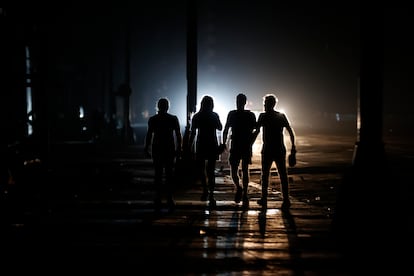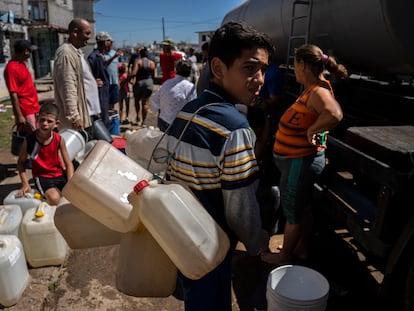The energy crisis paralyzing Cuba: ‘There will be no change in the electricity sector until the government changes the economic model’
Experts attribute the collapse to the island’s economic emergency: it relies on imports it cannot afford and on trading partners that are supplying increasingly diminishing amounts of oil

Cuban energy expert Jorge Piñón has compared Cuba’s electrical system to an “almendrón,” a term used in Cuba for the classic American cars from the 1950s that appear in every tourist photo. “The engine of the almendrón breaks down, a tire fails, and you fix it. Next month, it’s the carburetor, which will then break down. It’s as if you wanted to compete in the Monaco Grand Prix with that 1950s car,” says Piñón, the director of the Energy Program for Latin America and the Caribbean at the University of Texas.
Two years ago, Piñón warned about the potential collapse of the Cuban electrical system, a prediction that came true on October 17, when the entire country was plunged into darkness. Five days later, the government has yet to fully restore power, and food supplies are dwindling, water is scarce, and, above all, patience is wearing thin.
In three days, the Cuban electrical system collapsed at least four times. If a light bulb suddenly lit up in Havana, customers reported another power outage just two hours later. Some have endured 76 hours without electricity, watching their food rot in the refrigerator. Others are incommunicado, with family members unable to reach them, and several mothers are on the verge of a nervous breakdown as their children depend on artificial respirators. Despite this, Cuban President Miguel Díaz-Canel stated on X that while the country is experiencing a complex energy situation, there remains “Homeland, Revolution, and socialism, which guarantee protection for all.” This message upset more than a few people on social media, with many responding that “the problem is that the homeland, the revolution, and socialism cannot be eaten, do not end poverty, and do not provide healthcare.”
The “energy emergency” declared in Cuba on Friday was no surprise to economists, energy specialists, or even the general population. They were aware that a major blackout, which would leave them all in the dark, was imminent. It was not just another power outage; it represents a systemic failure in a country with aging infrastructure that does not produce enough energy to be self-sufficient. Cuba relies on imports it cannot afford and on trading partners that are supplying increasingly diminishing amounts of oil.
“Based on our observations, a major problem was practically just a matter of time,” says economist Ricardo Torres, a former researcher at the Association for the Study of the Cuban Economy (ASCE) and a professor at American University in Washington. “The deterioration of the electrical system is evident and has been for years. There are underlying issues at play. On one hand, the economy is performing so poorly that it is not generating enough foreign currency to purchase the necessary fuel. On the other hand, very little has been invested in the sector, which ultimately takes its toll. The contrast is evident when compared to the resources allocated to high-end hotels. There is a lot of talk about central planning, which should help anticipate these bottlenecks, but that has not been the case.”
What will happen next remains uncertain. On Monday, the Cuban Electric Union (UNE) announced that 50% of service to customers in Havana had been restored. Microsystems and “islands” have also been activated in some provinces across the country. Félix Estrada Rodríguez, the general director of the UNE’s National Power Office, stated that “the immediate strategy is to reorganize generation.” But specialists know that these are short-term solutions, and that the next national collapse could be just around the corner.
“Little by little, they will begin to implement enough temporary fixes to stabilize the situation, and we will return to where we were five or six months ago, but this will eventually happen again,” says Piñón. “There will be no meaningful change in the Cuban electricity sector until the government changes its economic model, decentralizes the economy, and allows open investment. Even then, it will take years; this process cannot happen overnight.”
Cuba, a history of blackouts
If anyone knows about blackouts, it is the Cubans who have lived through at least the last 30 years of them. The government has labeled each period of crisis: from the Special Period and the Energy Revolution to La Coyuntura, during which Cubans have gone without electricity for increasingly long periods of time.
When Cuba lost its main trading partner following the fall of the Soviet Union, the country entered the 1990s not only facing food shortages but also experiencing frequent daily power cuts. These conditions contributed to the protests known as El Maleconazo and the 1994 Cuban raft exodus to southern Florida.
In the 2000s, with Venezuela supplying much of the oil Cuba needed, it seemed the worst days of the Special Period were behind them. However, in May 2004, as is happening now, the Antonio Guiteras thermoelectric plant failed, severely impacting the National Electric System. Fidel Castro quickly took to national television to announce the “energy revolution,” which included measures aimed at encouraging Cuban families to conserve energy. His speeches, often featuring electric pots, explained the best ways for Cubans to cook their food efficiently. The government promptly began replacing all high-consumption appliances that people could no longer use due to the electricity shortages.
When the situation on the island worsened in 2019 due to shortages of food, medicine, and transportation — a crisis that continues today — the government referred to this period as a “conjunctural situation.” During this so-called “Conjuncture,” the island was once again hit with long blackouts. The pandemic then added further chaos to the national economy, creating a cumulative crisis whose long shadow extends to the present day.
Since losing aid from the USSR, the Cuban government has found other partners to navigate various crises, but solutions have never emerged from within. “Cuba has never managed to generate all the resources it needs to establish a robust energy system. These infrastructures are expensive, and a productive economy is needed to pay for them,” says Torres.
The last major energy crisis in Cuba began at least a decade ago, according to specialists. A joint report by Torres and Piñón indicates that since 1990, electricity generation has grown very slowly, at an annual rate of just 1.1%, which is only a third of the global average. The country’s energy system is primarily reliant on fossil fuels, which accounted for approximately 95% of electricity generation in 2022, with 48% of these fuels being imported.
Although the Cuban Electric Union has not provided updated data, Piñón and his team at the University of Texas estimate that the island’s consumption is around 120,000 barrels of oil per day. Of this total, Cuba produces only 40,000 barrels of its own crude. The remainder typically arrives from Venezuela (between 50,000 and 55,000 barrels per day), Mexico (between 20,000 and 22,000 barrels per day), and, in recent years, has been supplemented by aid from Russia. However, this assistance has also begun to dwindle.
The longstanding issues behind the blackout
The causes of the historic blackout on October 17, 2024 — which marks the longest total power outage ever recorded in Cuba — are neither new nor due to a storm like Hurricane Ian, which in 2022 led to the collapse of an already weakened energy network. The system’s infrastructure, suffering from insufficient maintenance, had long been signaling its impending collapse.
“The eight Cuban thermoelectric plants have been in operation for almost 40 years, and these plants require a high level of operational and capital maintenance, which UNE has not provided. This is what has caused all the problems we have seen in the last five years,” says Piñón. “The solution to these problems has always been short-term fixes, but not structural ones. Cuba’s plants need a total recapitalization.”
According to the expert, these plants process and use Cuban crude oil as fuel, “which is a very heavy crude oil, with a high content of sulfur and other metals that deteriorate and damage the units.” “We already knew that this was a problem, we have seen blackouts in the last five years — not as serious as these — but at some point it was inevitable,” he added.
Since 2019, the government has been relying on Turkish floating power plants, which, according to ONEI, are expected to provide nearly 25% of the total electricity consumed by 2023. Additionally, there are the so-called generator sets that were introduced in the early 2000s to alleviate the strain on thermal power plants; however, these also depend on fossil fuels for their operation. As a result, they do not offer a sustainable solution to the energy crisis
“The problem is that this is a shotgun strategy,” says Piñón. “You have hundreds of units and small generators everywhere, and this again requires maintenance and fuel almost constantly, and today the biggest problem with generator sets is that they don’t have fuel.”
In recent days, Cuban authorities have acknowledged that, beyond the deteriorating energy system or the increase in demand, the country’s main problem is the lack of fuel. Piñón points out that, last September, Venezuela sent Cuba half of the fuel it used to provide, that is, some 25,000 barrels. The South American country — which is dealing with its own crisis — is now focused on selling to companies such as PDVSA and Chevron.
“What is left over is what can be given to Cuba. So Venezuela’s volume has dropped by at least half in the last six months,” says Piñón. Mexico, which does not produce oil at the same level as Venezuela, has also reduced its shipments to the island by more than half. However, the most pressing question for the researcher is the whereabouts of the oil that is supposed to be arriving from Russia. In 2015, Russia extended a loan of €1.5 billion ($1.62 billion) to Cuba to construct four 200 MW power generation units for the Máximo Gómez and Este Habana thermoelectric plants. To date, the results of this investment have yet to materialize.
“We have read many headlines about agreements being signed with Russia to supply oil, they were going to work on refineries in Cienfuegos, they were going to increase production in Boca de Jaruco, but not a single Russian project has been carried out. Why?” asks Piñón. “Our opinion is that the Russians, like the Chinese, are tired of giving Cuba everything it needs and not being paid anything in return.”
A few years ago, China also offered resources to build the largest wind farm in Las Tunas, which has not yet been launched. “That is why the key word is management, and these people do not have the slightest idea of how to manage an emerging economy, there is no strategic plan,” says the researcher.
Clean energy: is it really the future for Cuba?
Amid the current emergency, Cuban Prime Minister Manuel Marrero stated that the solution to the problem is to “eliminate dependence on fossil fuels and replace them with clean energy.” Cuban authorities have committed to generating 37% of the country’s electricity from renewable sources by 2030, which requires an investment of 2,144 MW. However, Piñón is skeptical about the feasibility of this plan as a viable alternative to the current crisis.
“Cuba plans to generate 17% of its energy from bagasse or biomass under its 2030 plan. Imagine, if they recently announced that there will only be 15 power plants working in the next harvest and Cuba has to import sugar. How are you going to produce electricity from bagasse if the sugar industry is completely in ruin?” asks the expert. “You have wind power, but the projects are almost completely abandoned. And you have solar energy, we are all in favor of solar energy, it is a clean energy, but it has to be implemented in a strategic, well-planned way, and Cuba does not have the technology for that.”
The specialist believes that Cuba needs “time and money” to recover from this crisis. And that the future lies “in a balanced energy matrix, which has several fuel sources,” including renewable energies such as wind, biomass, solar, in addition to the thermoelectric plants that work with natural gas.
A team of researchers from Columbia Law School and the Sabin Center for Climate Change Law Monitoring published a report recommending that Cuba implement reforms to advance its transition toward a “lower-emission, reliable, and more climate-resilient” energy system.
Romany Webb, deputy director of the Sabin Center, emphasizes the importance of transitioning the island to a renewable energy system. “We know that Cuba’s current fossil-fuel-dominated system is unreliable. There are several reasons for this. One is that, as noted, fossil-fuel plants are old and poorly maintained,” she says. “But even without those problems, fossil-fuel plants are highly exposed to the effects of climate change. They tend to operate less efficiently and produce less at higher temperatures, and they rely on long-distance transmission infrastructure that is often affected by storms. Transitioning to a more distributed renewable energy system would help mitigate these risks.”
For Daniel Whittle, associate vice president and senior counsel at the Environmental Defense Fund and a participant in the research, the situation in Cuba closely resembles that of Puerto Rico before Hurricane Maria struck the island in 2017. “It features an overly centralized system, aging power plants, vulnerable transmission and distribution lines, and a bankrupt utility that has failed to invest in maintenance, repairs, and improvements,” he says.
“As Cuban government officials themselves have pointed out, there is no short-term solution. Building a system that provides reliable access to energy for the Cuban population will take many years and billions of dollars,” he adds.
Whittle and his team have been thinking about how Cuba’s power grid can be made cleaner and more resilient in the long term. But, he notes, this will require “a new way of thinking in Cuba and new policies and programs that incentivize and accelerate a transition to clean energy. Incentivizing rooftop solar and storage is particularly promising and will provide much-needed resilience, especially in rural areas.”
He also believes that Cuba cannot take on this mission alone. “It will need long-term international support to fund an overhaul of the system, and I hope that the United States can play a constructive role in providing and facilitating that support,” he says. “The current situation is a humanitarian crisis that warrants immediate international support to patch up the system and provide emergency fuel supplies.”
Cuban experts, however, believe that as long as the government continues to maintain a centralized economic model, there is no real solution. Torres and Piñón have calculated that Cuba would need between $8 and 10 billion in a decade to recapitalize the electric energy sector.
“The economic model does not work, it has been said in every possible way. So there is no sustained growth that allows investment, paying creditors to release more funds, and attracting foreign investment,” says Torres. “International capital is going to bet on countries that offer a future. That is why I think that a robust energy system cannot be built if the economy does not grow and for that, there has to be a radical transformation in the economic model.”
Sign up for our weekly newsletter to get more English-language news coverage from EL PAÍS USA Edition
Tu suscripción se está usando en otro dispositivo
¿Quieres añadir otro usuario a tu suscripción?
Si continúas leyendo en este dispositivo, no se podrá leer en el otro.
FlechaTu suscripción se está usando en otro dispositivo y solo puedes acceder a EL PAÍS desde un dispositivo a la vez.
Si quieres compartir tu cuenta, cambia tu suscripción a la modalidad Premium, así podrás añadir otro usuario. Cada uno accederá con su propia cuenta de email, lo que os permitirá personalizar vuestra experiencia en EL PAÍS.
¿Tienes una suscripción de empresa? Accede aquí para contratar más cuentas.
En el caso de no saber quién está usando tu cuenta, te recomendamos cambiar tu contraseña aquí.
Si decides continuar compartiendo tu cuenta, este mensaje se mostrará en tu dispositivo y en el de la otra persona que está usando tu cuenta de forma indefinida, afectando a tu experiencia de lectura. Puedes consultar aquí los términos y condiciones de la suscripción digital.
More information
Archived In
Últimas noticias
There is as much life left to discover on planet Earth as that which is already known
Dozens presumed dead, around 100 injured in fire at Swiss Alps bar during New Year’s celebration
Is porn for women different from conventional porn? We spoke to those who make it
Cartagena de Indias is sinking: What can the city do to mitigate it?
Most viewed
- Reinhard Genzel, Nobel laureate in physics: ‘One-minute videos will never give you the truth’
- Sinaloa Cartel war is taking its toll on Los Chapitos
- David King, chemist: ‘There are scientists studying how to cool the planet; nobody should stop these experiments from happening’
- Oona Chaplin: ‘I told James Cameron that I was living in a treehouse and starting a permaculture project with a friend’
- The Interoceanic Train, the Mexican alternative to the Panama Canal











































